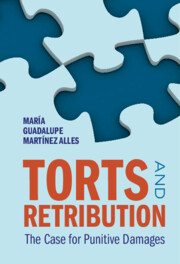Book contents
- Torts and Retribution
- Torts and Retribution
- Copyright page
- Dedication
- Epigraph
- Contents
- Preface
- Acknowledgments
- Introduction
- Part I The Place of Punishment in Torts
- Part II The Retributive Rationale
- Part III Retribution in the Mass-Market Setting
- Part IV Why Tort Law
- 9 The Significance of the Tort Victim
- 10 The Significance of the Tort Process
- Conclusion
- Bibliography
- Index
10 - The Significance of the Tort Process
from Part IV - Why Tort Law
Published online by Cambridge University Press: 09 August 2025
- Torts and Retribution
- Torts and Retribution
- Copyright page
- Dedication
- Epigraph
- Contents
- Preface
- Acknowledgments
- Introduction
- Part I The Place of Punishment in Torts
- Part II The Retributive Rationale
- Part III Retribution in the Mass-Market Setting
- Part IV Why Tort Law
- 9 The Significance of the Tort Victim
- 10 The Significance of the Tort Process
- Conclusion
- Bibliography
- Index
Summary
This chapter argues that the capacity of the tort process to generate other-regarding meaning and institutional knowledge is a compelling reason to maintain the institution and endeavor for its improvement. Tort lawsuits provide a means for developing and articulating collective standards of conduct. Punitive lawsuits themselves are apt examples of a meaning-producing institution because they embrace the values that are embodied in the condemnatory legal message and thus give collective backing to the message the victim wishes to convey: the wrongdoer is not somehow worth more than the victim and is not entitled to treat the victim in a manner that diminishes her relative value. Punitive lawsuits persuasively illustrate how tort responses are able to capture the moral significance of the wrongdoing in a way that communicates the situated meaning of the impact of reprehensible wrongs on the victims and their complex motivations for resorting to tort law and its procedure for private redress. Ultimately, punitive lawsuits are not isolated instances of tort litigation that take place in a vacuum – quite the opposite. Most frequently, they are better understood as occurring in articulation with and as complements to the actions of other relevant institutional actors in our democratic societies.
Keywords
Information
- Type
- Chapter
- Information
- Torts and RetributionThe Case for Punitive Damages, pp. 250 - 264Publisher: Cambridge University PressPrint publication year: 2025
Accessibility standard: WCAG 2.0 AA
Why this information is here
This section outlines the accessibility features of this content - including support for screen readers, full keyboard navigation and high-contrast display options. This may not be relevant for you.Accessibility Information
Content Navigation
Allows you to navigate directly to chapters, sections, or non‐text items through a linked table of contents, reducing the need for extensive scrolling.
Provides an interactive index, letting you go straight to where a term or subject appears in the text without manual searching.
Reading Order & Textual Equivalents
You will encounter all content (including footnotes, captions, etc.) in a clear, sequential flow, making it easier to follow with assistive tools like screen readers.
Structural and Technical Features
You gain clarity from ARIA (Accessible Rich Internet Applications) roles and attributes, as they help assistive technologies interpret how each part of the content functions.
